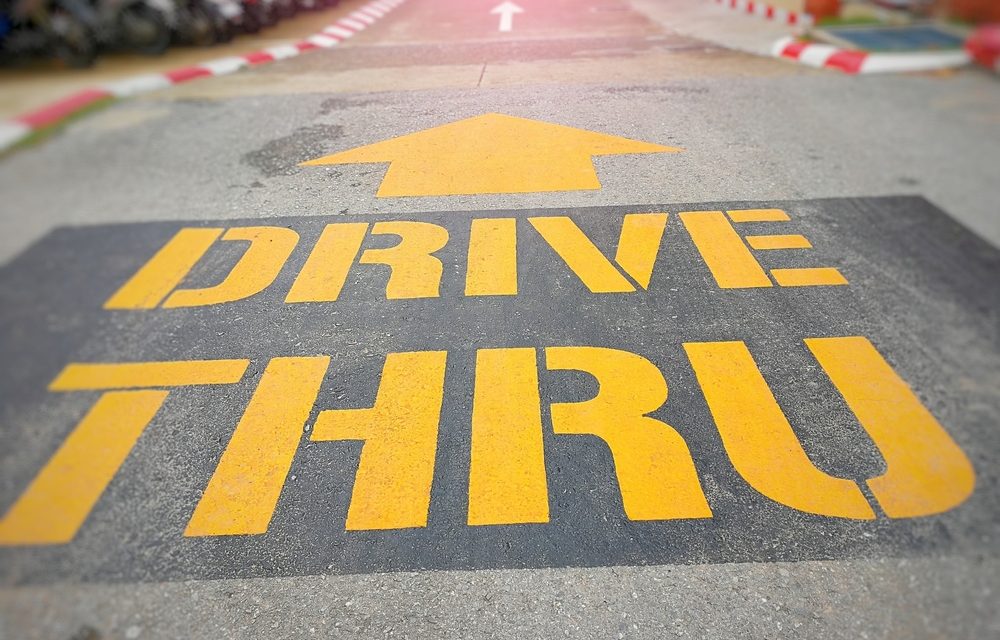by: Rakuten Ready
Source: rakutenready.com, June 2020
We all know the traditional drive-thru model of entering the long drive-thru lane, waiting patiently to order and pay, and finally grabbing our food at the pickup window and heading out.
With drive-thru revenue averaging 60-70% for the typical QSR, operators created a drive-thru experience that was fast, efficient, and convenient as possible. Still, drive-thrus have never been known as the best way to get your food if you’re in a hurry. In 2019, customers spent an average of 4 minutes 15 seconds waiting to collect their orders, about 20 seconds longer than in 2018.
However, the impact of COVID-19 has changed consumers’ expectations of the drive-thru channel dramatically and likely forever, in a very short time. Customers still want speed now that the priority is their safety and health when shopping or ordering food.
COVID-19 has changed drive-thrus forever
We know from our new Rakuten Ready Playbook for Contactless Experiences, consumers rank the visibility of contactless protocols as their top priority for feeling safe when picking up orders from their favorite merchants. Consumer behavior has created an urgency for brands to focus on safety by rapidly shifting to a contactless drive-thru experience across the entire customer journey.
Placing an order using the mobile app before arriving at the drive-thru has been a thing for many savvy drive-thru customers, allowing them to avoid the order and pay window and proceed directly to the pickup window. It was not always condoned but now it is becoming mainstream with the mobile order ahead drive-thru trend catching on with operators.
Dunkin’ has been rolling out mobile order-only lanes, while Chipotle has invested in drive-thru for the first time by opening 85 mobile-only pickup lanes called Chipotlanes. Habit Burger has been testing pop-up drive-thru lanes at 39 restaurants allowing orders through their digital channels or through an employee working in the lane taking orders with a tablet.
The benefits of a contactless drive-thru experience:
Offering a contactless experience in the drive-thru has many benefits for customers, employees, and operators:
- Lowers the average wait time by speeding up the line at the drive-thru window since more customers will order and pay before they arrive.
- Prioritizes the safety of customers and employees by lowering the risk of virus transmission with a contactless handoff experience.
- Increases order throughput and revenue by influencing customers to order more efficiently with the mobile app and speed up the drive-thru experience.
“Our mobile-ordering approach allows our customers to check-in when they arrive at our restaurant,” Deepak Ajmani, VP of US Operations at Wendy’s says. “This ensures that their order goes to the kitchen at the right time and their food is hot and fresh as they arrive at the pickup window.”
The contactless drive-thru experience is here to stay
Led by brands such as Chick-Fil-A, Arby’s, Wendy’s, Taco Bell, and Starbucks and embraced by customers, the contactless drive-thru experience is accelerating faster than anyone ever expected.
Chick-Fil-A and Taco Bell have implemented best-in-class contactless drive-thru experiences across their U.S. locations including:
- Encouraging customers to order online or via the brand app which provides a contactless payment and order solution
- Confirming orders via a mobile receipt or QR code shown through the window
- Ensuring the cashiers never handle bagged or boxed food
- Dedicating “food only” employee to hand off food without contact
Best practices will require innovation
Drive-thrus typically have limited space, so brands will need to be innovative when looking at how to integrate new processes and ideas, such as:
- Changing the old “pay-only” window to an “order ahead only” window with a “pullaway” lane. Basically an order ahead customer can then pickup their food at the first window and exit the drive-thru via a designated pullaway lane which speeds up their wait time and decreases the bottleneck for others.
The pickup window would handle traditional payment and handoff with a cashier and a different employee handing off each order.
According to Strategywise, a pullaway lane would reduce the average drive-thru wait time by 15% and increase order throughput by 19%.
- Designating employees (“runners”) to take contactless orders and payment (via tablets) as customers enter the line (i.e. the Chick-Fil-A model) eliminating the stop at the payment window and speeding up the line.
- Providing special parking spots in which customers wait for large or complex orders with employees placing the orders in the trunk while customers stay safely in their car.
- Leveraging predictive arrival technology so the kitchen is alerted when an online customer arrives and the order can be ready right as the customer pulls up to the pickup window.
A contactless drive-thru order experience is not only safer for both consumers and employees but provides a valuable opportunity to decrease wait times, increase order throughput and drive incremental revenue.
Rakuten Ready is Here to Help with Your Contactless Experience
At Rakuten Ready, as the leaders in predictive arrival technology, we focus on delivering a seamless, efficient, and safe contactless drive-thru experience. Our technology powers contactless orders and payment, optimizes order prep, and accurately predicts when a customer is approaching and alerts employees so they can ensure orders are ready right when the customer arrives.
Connect with us to understand how Rakuten Ready can assist your brand with planning and executing contactless drive-thru experiences.

